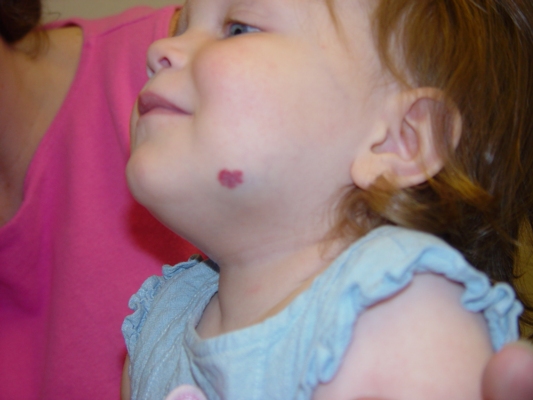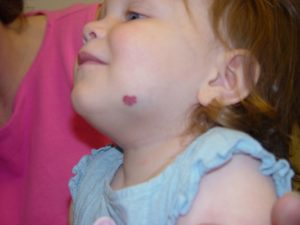Baby birthmarks & rashes
Many babies also get rashes or have birthmarks. In this article, seven kinds of rashes and birthmarks are discussed.
Mongolian Spots
These birthmarks can vary considerably in size but are all flat areas of skin that contain extra pigment, which causes them to appear brown, gray, or even blue (like a bruise). Most often located on the back or buttocks, Mongolian spots are very common, especially in dark- skinned babies. They usually disappear before school age and are of no medical significance.
Pustular Melanosis
Small blisters that typically appear at birth, they peel open and dry up within a couple of days. They leave dark spots like freckles that usually disappear over several weeks. Some newborns may have only the spots, indicating that they had the rash before birth. While pustular melanosis is common (particularly in babies with darker skin) and is a harmless newborn rash, it is always important to have all blister like rashes evaluated by your baby’s doctor to make sure they aren’t due to an infection.
Milia
These tiny white bumps or yellow spots are found on the cheeks, chin, or across the tip of the nose, and are caused by skin-gland secretion. This common newborn rash generally disappears on its own within the first two to three weeks of life.
Miliaria
Often referred to as a “heat rash” or “prickly heat,” miliaria most often occurs in hot, humid climates or when babies are over-bundled. The rash can contain tiny sweat blisters and/or small red bumps. It shows up most often in skin folds and covered areas, and usually goes away within a few days.
Erythema Toxicum
Often called “E tox” for short, this rash is very common and usually appears within the first few days after birth. It consists of multiple red splotches with yellowish-white bumps in the center, and goes away within a week or so. It generally resolves if it’s left completely alone.
Capillary Hemangiomas
These raised red spots are caused by a strawberry-like collection of blood vessels in the skin. For the first week or so, they may appear white or pale, then turn red later. While they often enlarge during the first year, most shrink and almost disappear by the time a child reaches school age usually without requiring treatment.
Port Wine Stain
Large, flat, and irregularly shaped dark red or purple areas. Caused by extra blood vessels under the skin, port wine stains are usually located on the face or neck but, unlike hemangiomas, don’t disappear without treatment. These birthmarks can be treated, sometimes with laser surgery by either a plastic surgeon or a pediatric dermatologist.
If your baby was born vaginally, in addition to the elongated shape of his head, there also may be some scalp swelling in the area that was pushed out first during birth. If you press gently on this area, your finger may even leave a small indentation. This swelling (called caput) is not serious and should disappear in a few days.



Leave a Reply